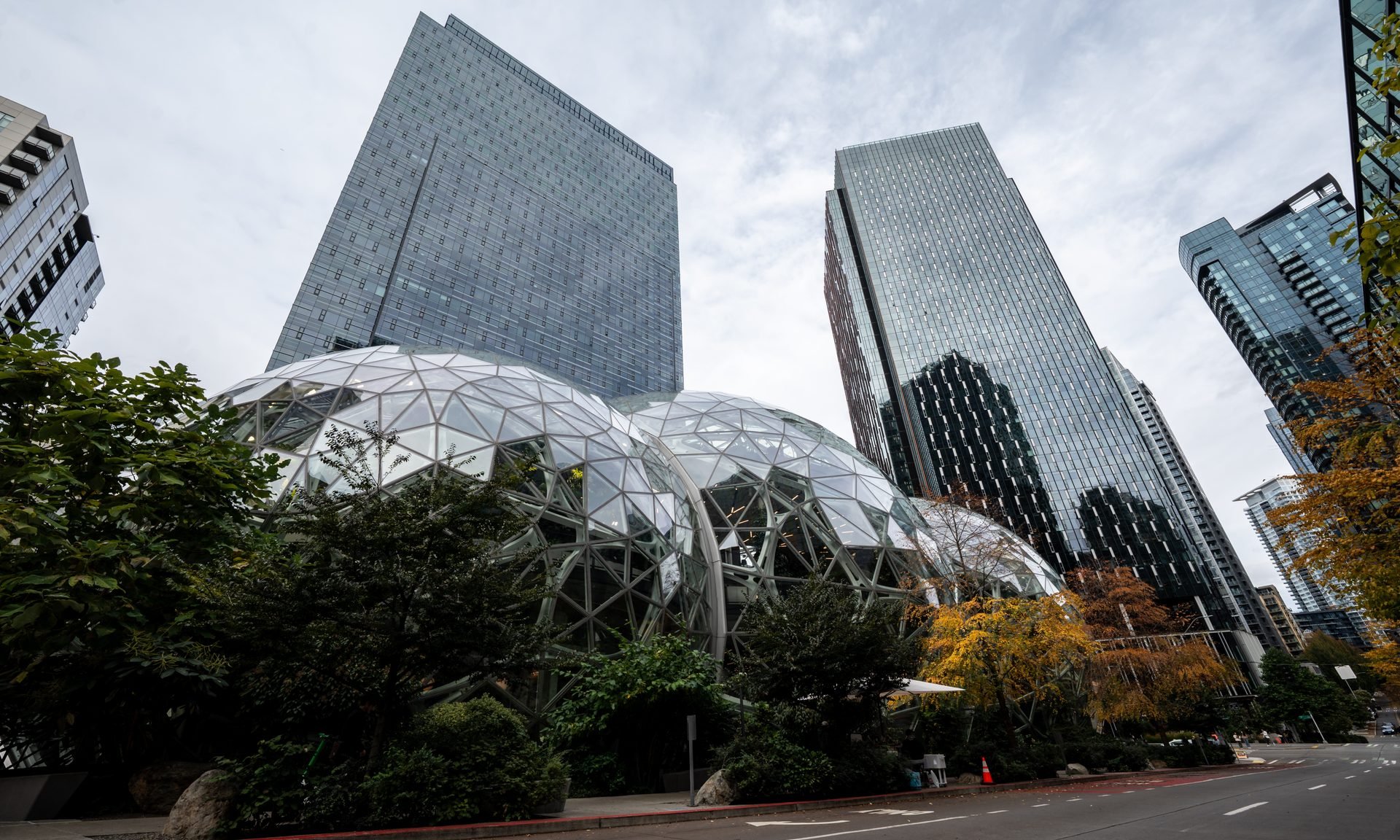Tech Layoffs: Amazon Announces It Will Cut 14,000 Jobs
So far in 2025, some 218 tech companies have laid off more than 112,000 employees, according to layoffs.fyi.

Many, or all, of the products featured on this page are from our advertising partners who compensate us when you take certain actions on our website or click to take an action on their website. However, this does not influence our evaluations. Our opinions are our own. Here is a list of our partners and here's how we make money.
Updated on Oct. 28.
On Oct. 28, Amazon confirmed 14,000 corporate job cuts across multiple divisions. In a message to employees, an Amazon executive cited a goal of “further reducing bureaucracy, removing layers, and shifting resources.”
Advances in AI were cited as well. “This generation of AI is the most transformative technology we’ve seen since the Internet, and it's enabling companies to innovate much faster than ever before,” according to the message from Beth Galetti, Amazon’s senior vice president of People Experience and Technology. “We’re convinced that we need to be organized more leanly, with fewer layers and more ownership, to move as quickly as possible for our customers and business.”
Other notable tech layoffs in October:
- Paramount Skydance, an entertainment and media conglomerate, will begin trimming 1,000 jobs following a recent merger, several sources reported.
- Chegg, an educational technology company, said it would trim 388 roles. According to Reuters, the company said the "new realities of AI and reduced traffic from Google to content publishers have led to a significant decline in Chegg's traffic and revenue."
- Applied Materials, a producer of chipmaking equipment, said it would cut 4% of its global workforce (an estimated 1,400 jobs) in the face of a sales slowdown sparked by trade turmoil.
- Electric-vehicle maker Rivian cut more 600 jobs after the end of a federal tax credit weakened demand.
- Meta, the parent company of Facebook, said it would trim 600 jobs within its AI unit.
Tech companies have been consistently laying off employees since late 2022. The rapid rise of artificial intelligence adoption has fueled some of the most recent layoffs in the industry.
In 2025, some 204 companies have laid off approximately 89,964 employees, according to layoffs.fyi., which tracks job cuts in the tech industry.
Why this matters: The tech industry is sometimes seen as a bellwether of what’s happening in the broader economy. Layoffs could signal that investor confidence is declining and even slowing economic growth.
» MORE: How is the economy doing?
Beginning in 2022, tech layoffs increased steadily before hitting a peak of 585 companies in the first quarter of 2023, according to layoffs.fyi. Since then, tech layoffs have declined. In 2024, some 542 tech companies laid off 151,484 employees
These layoffs are an outlier in an otherwise strong job market: The unemployment rate hovered between 3.4% and 3.9% Dec. 2021 to April 2024, Bureau of Labor Statistics data shows. Since then, unemployment has ticked up, hitting 4.2% for April.
Meet MoneyNerd, your weekly news decoder
So much news. So little time. NerdWallet's new weekly newsletter makes sense of the headlines that affect your wallet.
Employment, at large, is doing well. But when layoffs are happening in the most visible sector on the internet, you’re going to hear about it.
What tech companies have laid off workers recently?
Notable tech layoffs in September:
- On Sept. 12, xAI, Elon Musk’s AI company, laid off 500 workers.
- On Sept. 8, Microsoft laid off 42 jobs at its Redmond, Wash. headquarters.
- On Sept. 5, Rivian, an EV startup, laid off 200 workers.
- On Sept. 4, Gupshup, a conversational AI company, laid off 100 workers.
- In early September, Salesforce laid off 385 workers. On Aug. 31, Salesforce laid off 4,000 workers.
- In early September, Oracle, an enterprise software and cloud services company, laid 254 off workers in San Francisco and 101 workers in Seattle as part of a nationwide round of layoffs. Oracle staff in Kansas, Massachusetts and Texas also reported layoffs.
Notable tech layoffs in August:
- Throughout August, Oracle, an enterprise software and cloud services company, has held multiple layoffs, totaling 450 workers.
- On Aug. 25, Klaviyo, an email and SMS marketing platform, held layoffs. It’s unclear how many workers were let go.
- On Aug. 19, Cisco, a networking and cybersecurity tech company, laid off 221 workers.
- On Aug. 13, F5, a cloud app security and delivery company, laid off106 workers, representing about 2% of its staff.
- On Aug. 15, Kyte, a car rental startup, shut down.
- On Aug. 14, Restaurant365, a restaurant management software company, laid off 100 workers.
- On Aug. 4, Wondery, a podcast company owned by Amazon, laid off 100 workers as part of a restructuring of its podcast strategy.
Notable tech layoffs in July:
- On July 22, ConsenSys, a crypto software company, laid off 47 workers or about 7% of its staff.
- On July 21, Zeen, a social media collaging platform company, shut down.
- On July 18, Rocket Companies, a fintech and mortgages company, cut 2% of its workforce.
- On July 17, Amazon cut staff in its cloud computing unit. It’s unclear how many workers were laid off
- On July 16, Scale AI, a data-labeling company, laid off 14% of its staff.
- On July 16, Jamf, an Apple software and security company, laid off 6% of its workforce.
- On July 15, Lenovo laid off 3% of its workforce — about 100 employees nationwide.
- Throughout July, Intel announced mass layoffs at multiple U.S. locations. On July 11, the company said that around 2,400 workers in Oregon would be laid off — up from its initial plans to lay off 500 workers. The company also said it would be cutting 1,935 jobs in California at its Folsom and Santa Clara locations. And in Chandler, Ariz., nearly 700 positions will be eliminated. Estimates place the total Intel layoffs in the U.S. at about 5,000.
- On July 11, Indeed + Glassdoor announced plans to lay off 1,300 positions, as part of restructuring efforts.
- On July 7, ByteDance, which owns TikTok, laid off 65 workers at its Bellevue, Wash. location.
- On July 2, Microsoft laid off about 4% of its global workforce or roughly 9,000 employees.
Notable tech layoffs in June:
- On June 25, Bumble, the dating app, announced it would be laying off 240 workers, or about 30% of its staff.
- On June 16, Intel announced it would lay off 15% to 20% of its design and manufacturing workforce.
- On June 2, Microsoft laid off more than 300 workers in Washington state.
Notable tech layoffs in May:
- On May 27, nCino, a fintech company, laid off 1,880 people or 7% of its global staff.
- On May 19, Blink Charging, an electric vehicle charging company, laid off 20% of its workforce.
- On May 14, Amazon laid off 100 employees in its devices and services unit.
- On May 13, Microsoft laid off 6,000 workers, or about 3% of its staff.
- On May 12, Chegg, an education tech company, laid off 22% of its staff, or about 248 workers.
- On May 8, Match Group, a dating app, laid off 325 of its employees, or about 13% of its workforce.
- On May 7, CrowdStrike, a cyber security company, said it would lay off some 500 of its workers.
Notable tech layoffs in April:
- On April 29, Electronic Arts, a major video game company, laid off around 300 workers.
- On April 28, Expedia, the travel website, laid off 3% of its workforce.
- On April 23, Intel said it was planning to lay off 22,000 workers, or about 20% of its staff.
- On April 16, Turo, a peer-to-peer car rental startup, said it was laying off 15% of its workers. The company cut staff following its decision to not go public.
- On April 11, Google laid off hundreds of employees in its platforms and devices unit.
- On April 10, General Motors laid off 200 workers at its Factory Zero plants in Detroit and Hamtramck, Mich. The plants produce GM’s electric vehicles and the majority of the layoffs are in the battery pack manufacturing area.
- On April 2, Automattic, the maker of Wordpress.com and other online platforms, said it was laying off 16% of its staff, or around 270 workers.
Notable tech layoffs in March:
- On March 3, Rec Room, an online gaming company, laid off 16% of its staff.
- On March 6, Hewlett Packard Enterprise (HPE) said it would lay off 2,500 workers or 5% of its staff.
- On March 7, LiveRamp, a SaaS company, laid off 5% of its full-time workforce.
- On March 7, Wayfair, a home goods retailer, cut 340 workers in its Technology division.
- On March 17, HelloFresh, a meal kit company, announced it was laying off 273 workers.
- On March 19, Sequoia, a compensation and benefits company, confirmed it was laying off all workers in its D.C. office.
- On March 25, Block, a financial services provider owned by billionaire Jack Dorsey, reportedly laid off 931 employees, or about 8% of its staff.
Notable tech layoffs in February:
- On Feb. 28, HP, the information technology giant, laid off 2,000 workers.
- On Feb. 28, Grubhub, a food delivery app, laid off 500 workers, or 23% of its staff.
- On Feb. 27, Autodesk, a software corporation, laid off 1,350 workers or 9% of its staff.
- On Feb. 20, SeatGeek, an event ticketing platform, laid off 150 workers or 15% of its staff.
- On Feb. 13, Blue Origin, a space technology company owned by billionaire Jeff Bezos, laid off 1,000 workers or 10% of its staff.
- On Feb. 12, Redfin, a real estate website, laid off 450 workers.
- On Feb. 10, Meta laid off 3,600 workers or about 5% of its staff.
- On Feb. 10, Justworks, an HR software company, laid off 200 workers.
Notable tech layoffs in January:
- On Jan. 21, Stripe, a fintech company, laid off 300 workers.
- On Jan. 16, Aurora Solar, a solar energy software company, laid off 58 people.
- On Jan. 15, Microsoft confirmed that it would be cutting staff this year. Reports estimate about 1% of its global workforce would be impacted.
- On Jan. 15, Meta said that it would lay off 5% of its staff, or about 3,600 workers.
- On. Jan 14, Textio, an A.I. and machine learning recruiting company, laid off 15 workers.
- On Jan. 10, Zillow, the real estate website, confirmed that it had laid off staff, but didn’t specify how many workers were impacted.
- On Jan. 9, Redfin, the real estate website, laid off 46 employees.
- On Jan. 9, Vox, a news website owned by Vox Media, laid off an unspecified number of employees.
- On Jan. 9, Microsoft confirmed that it is planning to layoff employees soon. It's unclear how many workers would be impacted.
- On Jan. 7, Aqua Security, a cyber security company, laid off dozens of employees.
What’s going on with layoffs in tech?
The biggest tech layoffs have occurred at high-profile companies. During 2024, the biggest companies with major layoffs included Microsoft, Google, Tesla, eBay, PayPal, Expedia Group, Intuit, TikTok, Salesforce and others.
Cutbacks in 2023 and late 2022 included mass layoffs at Accenture, an IT company; Amazon; Meta, which owns Facebook and Instagram; Zoom Video Communications, Inc.; Dell; Spotify; Google-parent Alphabet; Microsoft; and Twitter.
Other big-name companies laid off employees in 2023 and they run gamut of what tech has to offer: crypto (Coinbase), e-commerce (Shopify), ridesharing (Lyft), online payments (Stripe), work management platform (Asana) and an online real estate broker (Redfin). The list goes on and on.
When did all of the tech layoffs start?
Roger Lee, creator of Layoffs.fyi, has been following layoffs in tech since 2020 as startups started laying off employees during the early days of the pandemic. According to Lee, the pandemic created an opportunity for people to increasingly turn to the Internet for work, shopping and socializing. In response, tech companies went on a hiring spree to meet consumer demand.
This growth in tech employment started in late 2020 and lasted through 2021. At the same time the Federal Reserve’s policy slashed interest rates throughout 2021, which enabled tech companies to raise capital and invest in growth, Lee said. But both trends reversed in early 2022.
The majority of layoffs at the beginning of 2022 came from startups, according to Lee. But in late 2022 and early 2023 it started to creep into bigger tech, as well. Lee also said that “Big Tech” layoffs like those seen at Meta and Twitter “present a unique opportunity to recruit a caliber of talent that would've previously been impossible to attract.”
(Photo by Stephen Brashear/Getty Images)
Meet MoneyNerd, your weekly news decoder
So much news. So little time. NerdWallet's new weekly newsletter makes sense of the headlines that affect your wallet.
Article sources
NerdWallet writers are subject matter authorities who use primary,
trustworthy sources to inform their work, including peer-reviewed
studies, government websites, academic research and interviews with
industry experts. All content is fact-checked for accuracy, timeliness
and relevance. You can learn more about NerdWallet's high
standards for journalism by reading our
editorial guidelines.
Related articles







